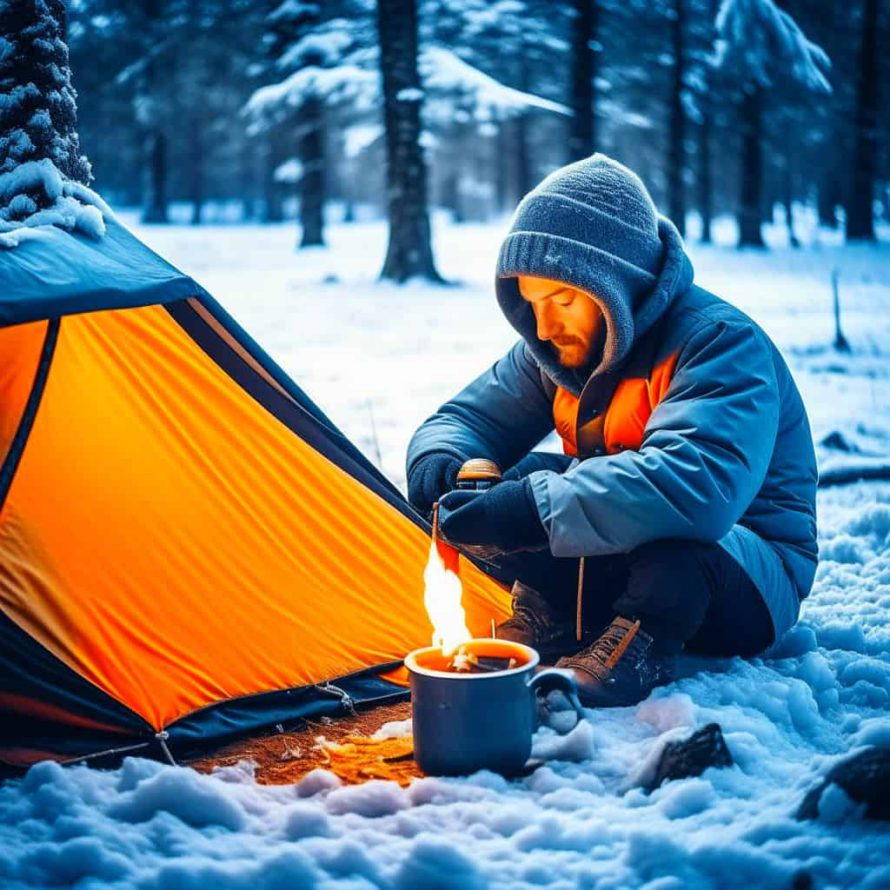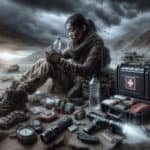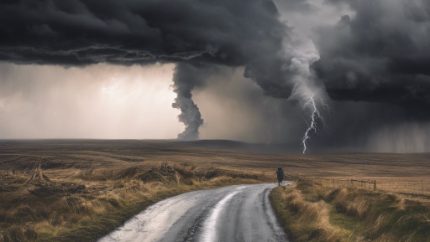Hypothermia in Winter: Practical Steps for Keeping Your Body Warm
Appreciating snow-covered landscapes and cozy evenings by the fire isn’t enough to fully embrace winter’s wonderful charm. Being hypervigilant is essential, as hypothermia is a real possibility and may transform a beautiful winter sight into a terrifying nightmare. Being well-informed and prepared is crucial for your safety, whether you’re a daring explorer venturing into the icy peaks or a naive traveler swept up in an unexpected snowfall.
The harshness of winter heightens the danger of hypothermia, a medical emergency in which the core body temperature falls to an unsafe level because of an imbalance between heat loss and production. To successfully traverse this terrifying obstacle, it is crucial to understand the practical measures for response and prevention.

The first and most important step in successfully surviving cold weather is to develop a strong layering system. To keep dry, the skin-to-skin layer should act as a wick; to keep warm, the middle layers should act as insulation. The outer layer’s protection forms an all-encompassing barrier against the elements from wind and rain. This layering technique works better using insulating materials like down or fleece and moisture-wicking fabrics.
Furthermore, it is critical to remain dry during winter weather. The danger of hypothermia increases dramatically when skin and clothes are wet because they hasten the rate of heat loss. Protect yourself from the dampness that can reduce your body’s thermal insulation by donning moisture-wicking pants and clothing that is both waterproof and breathable.
One further important aspect is knowing how the body’s heat is distributed. Protect the central nervous system, which contains many important blood arteries, and the head and neck. Protecting these areas and adding to total heat retention are both achieved by wearing high-quality thermal layers, a scarf, and a cap.
In addition, it is critical to recognize that food and water play a part in preventing hypothermia. Fueling the body’s heat production process is consuming easily digestible, high-energy foods. Even in colder climates, staying hydrated helps with critical metabolic processes to stabilize the core temperature.
A Closer Look at the Chilling Threat
Before delving into the consequences of hypothermia, it is necessary to peel back the layers of this chilling occurrence; at its foundation, hypothermia is caused by a complicated interplay between the body and its surroundings. This syndrome occurs when the body’s heat loss exceeds its heat generation capacity, resulting in a dangerously low core temperature. This decline in temperature sets off a chain reaction of physiological responses that go far beyond basic pain.
The body’s fundamental functions are under attack as the core temperature drops. The effects go far beyond the discomfort associated with cold weather. Indeed, hypothermia is a serious threat to one’s well-being, with severe health problems and, in the worst-case scenario, death. Recognizing the gravity of the issue emphasizes the significance of taking a proactive approach—addressing hypothermia before it reaches a catastrophic stage.
The human body relies on a delicate temperature balance to function efficiently in its astonishing complexity. As hypothermia sets in, this equilibrium is upset, with ramifications across multiple physiological systems. Cardiovascular strain is visible when the heart works harder to pump blood in order to compensate for the freezing effects on circulation. Meanwhile, respiratory activities may slow, making refilling oxygen to important organs more difficult.
Understanding the subtle indications and symptoms is critical in the fight against hypothermia. Shivering, which begins as a mechanism to generate heat, can become a desperate, uncontrollable response as the body fights to combat the cold. Cold and pale skin, which was formerly a visual manifestation of the body’s normal state, now serves as an alarming indicator of its weakened ability to sustain warmth.
Furthermore, the effects of hypothermia extend beyond the physical domain, affecting cognitive functions. Slurred speech and bewilderment are unmistakable indicators of the brain’s attempt to keep up with the body’s cooling. It’s not only about surviving the cold; it’s about defending the basic essence of life.
Recognizing the Signs of Hypothermia
The capacity to recognize the subtle yet vital signs and symptoms of hypothermia is an essential talent in the field of winter survival. Knowing these warning signs can mean the difference between timely intervention and exacerbating a possibly fatal scenario. Understanding the complexities of hypothermia enables people to strike a careful balance between exposure to cold temperatures and the body’s ability to preserve core warmth.
- Shivering: The Body’s Initial Defense Mechanism: The body’s first line of defense against temperature loss is shivering, an instinctual response to cold. A physiological system creates heat while keeping the core temperature stable. While shivering is a natural and adaptive reaction, excessive and uncontrollable shivering may indicate the onset of hypothermia. Recognizing the subtleties of shivering patterns is critical since they can be an early warning indication that should not be ignored.
- Cold and Pale Skin: A Visual Indicator of Distress: As hypothermia progresses, the skin changes noticeably, becoming cold to the touch and taking on a bluish or pale tint. This change in skin color suggests poor blood circulation and the body’s struggle to maintain a healthy temperature. Understanding this visual cue improves the observer’s capacity to determine the seriousness of the condition, leading to decisive action to reduce the risks associated with advancing hypothermia.
- Slurred Speech and Cognitive Impairment: Unmasking Hypothermia’s Impact on the Brain: Hypothermia’s insidious nature extends beyond the physical domain and infiltrates cognitive functions. Slurred speech, disorientation, and even tiredness indicate impaired brain function. These manifestations highlight the critical need for intervention, as the brain falters in coordinating important physical systems when deprived of the required warmth. Recognizing these cognitive symptoms is critical for quickly responding to the development of hypothermia.
- Weakness and Lack of Coordination: Physical Manifestations of Hypothermic Stress: As hypothermia progresses, it causes visible physical signs such as muscle weakness, awkwardness, and a noticeable lack of coordination. These symptoms highlight the systemic impact of hypothermia, which affects not only the extremities but also the core musculature. Individuals suffering from these symptoms may find ordinary chores difficult, and their physical limitations may exaggerate the overall risk of their situation. Increased awareness of these indications allows for self-recognition and identification of hypothermia in others, allowing for a more rapid and effective response.
Effective Measures to Combat Hypothermia
The capacity to recognize the symptoms of hypothermia is merely the first step in winter survival. Now, let’s look at some practical steps to help you battle hypothermia and keep your body warm and resilient in the face of cold circumstances.
- Dress Strategically for Maximum Insulation: Layering your clothing is a smart technique for conserving body heat, not just a means of remaining warm. The idea is to start with a moisture-wicking base layer that keeps your skin dry and prevents dampness from chilling you. Add an insulating garment, such as a fleece or down jacket, over this to trap warmth close to your body. To protect against the weather, finish with a windproof and waterproof outer shell. Cotton clothing, in particular, retains moisture and promotes heat loss, undermining your efforts to stay warm.
- Guard Your Extremities from Heat Loss: Heat is dissipated mostly through the hands, feet, and head. To create a barrier against heat loss, invest in high-quality gloves, thick socks, and a dependable hat or beanie. Additionally, use materials such as insulated insoles or heated boot liners to insulate your footwear, preventing cold from seeping in and reducing your body’s general warmth.
- Prioritize Dryness as a Preventive Measure: Wet clothing is a strong inducer of hypothermia. Prioritize remaining dry by using waterproof materials or strategically layering garments. If you get wet, seek shelter as soon as possible and change into dry clothes to avoid a sudden drop in body temperature.
- Improvised Insulation for Critical Areas: Incorporate widely available materials to improve the insulation of your garment. Stuffing leaves, grass, or any insulating substance between your garment layers, especially around important areas like the torso, will dramatically improve your clothing’s ability to retain heat.
- Shelter as a Fundamental Requirement: In a winter survival crisis, seeking shelter is more than a consideration; it is a requirement. Natural shelters such as caves, overhanging boulders, and fallen trees provide refuge from the piercing cold. If such shelters are not accessible, building an emergency shelter out of branches and snow becomes an important ability.
- Harness the Power of Controlled Heat Sources: Fire becomes an invaluable ally in the fight against hypothermia. Learn how to build a fire in various settings, and always keep dependable fire-starting materials on hand. Prioritise safety by having a proper fire pit or defined area to restrict the fire, reducing dangers in your quest for warmth.
- Sustain Your Body with Hydration and Nutrition: Hydration and diet are critical in regulating body temperature. Make sure you have access to clean water or, if necessary, melt snow to stay hydrated. Consume high-energy meals such as nuts, dried fruits, and energy bars to give your body the fuel it needs to generate heat.
- Leverage the Buddy System for Collective Warmth: The saying “strength in numbers” is accurate, especially in frigid climates. Travel with a spouse or a group to benefit from the shared body heat, which can considerably add to collective warmth. Maintain alert for signs of hypothermia in one another, creating a supportive environment for the duration of your winter journey.
Incorporating these practical techniques into your winter survival toolkit strengthens your defenses against hypothermia and empowers you to appreciate winter’s beauty with confidence and resilience. Remember that prevention is key, but with knowledge and preparation, you can manage the cold with the confidence of a seasoned winter adventurer.
Remember that the information in this blog post is only for educational reasons. While these practical actions can be extremely successful in treating hypothermia, they must be tailored to your personal condition and, if necessary, seek guidance from professionals.
Post-Disaster Bartering: Essential Strategies
Exploring the Concept of Post-Disaster Bartering What Is the Concept of Post-Disaster Bartering? Post-Disaster Bartering: Post-disaster bartering refers to the exchange of goods and services that occurs when conventional currency systems collapse due to catastrophic events, such as natural disasters, economic crises, or societal upheavals. During these critical moments, individuals and communities utilise the resources […]
Hurricane Generator Use: Powering Through Storms
Maximising the Benefits of Hurricane Generator Usage What Exactly Are Hurricane Generators? Hurricane Generator Use: Hurricane generators are advanced power supply devices specifically engineered to deliver electricity during extreme weather events, particularly during hurricanes, when standard power infrastructures may fail. These robust machines ensure that both residential and commercial establishments receive the power they need, […]
Emergency Family Plan: Universal Preparation Guide
Comprehensive Elements to Include in Your Family Emergency Plan Effective Communication Strategies for Emergencies Emergency Family Plan: Establishing effective communication strategies is absolutely vital for ensuring that family members remain connected and informed during emergencies. It’s crucial to have clear, reliable methods in place that everyone understands and can utilise effortlessly. This encompasses traditional communication […]
Survival Water Bottles: Essential Gear for Emergencies
Why Survival Water Bottles are Essential for Emergency Preparedness Understanding the Significance of Hydration in Crisis Situations Survival Water Bottles: Maintaining hydration is vital for ensuring optimal bodily functions during emergencies. In scenarios where access to clean water is limited, sustaining proper hydration is crucial in preventing health complications associated with dehydration, which can include […]








You bring up an incredibly important topic that often gets overlooked during the more picturesque moments of winter. While I enjoy the beauty of snow-covered landscapes as much as anyone, it’s crucial to remember how quickly winter can turn against us. Your emphasis on a strong layering system resonates deeply. I’ve learned this lesson the hard way during a winter hike where I underestimated the chill and ended up shivering uncontrollably despite wearing what I thought was enough clothing.
You’ve hit the nail on the head with your thoughts about the beauty of winter contrasting with its harsher realities. It’s easy to get lost in the serene scenes, but as you experienced, the cold can sneak up on us when we least expect it. Layering really is an art—what’s comfortable in the car or at the start of a hike can quickly turn into a mistake once you hit that chilly breeze.
It’s interesting how nature can catch us off guard, isn’t it? Your experience highlights a crucial aspect many overlook—conditions can change rapidly in winter, transforming what seems like a pleasant outing into a struggle for warmth.
You nailed it. Winter can be deceptively beautiful, but it’s a bit of a trickster too. The picturesque scenery often makes it easy to forget how quickly things can change out there. I’ve found myself in some pretty cold situations as well, usually while I’m too focused on capturing that perfect winter shot. That moment of realizing the chill has set in and your gear isn’t cutting it is alarming.
You bring up a really interesting point about winter’s deceptive beauty. I think the allure of that pristine snow and those stunning landscapes can almost lure us into a false sense of security. I’ve been there too, caught up in the moment, trying to get that perfect shot. It’s like the elements have a way of disguising their power, isn’t it?
You’ve articulated something that resonates deeply. The way winter crafts those picturesque scenes can absolutely create a sense of tranquility, almost like a visual lullaby. It’s easy to become mesmerized by the soft blanket of snow, the way it transforms familiar landscapes into something ethereal. In those moments, we forget that beneath that beautiful surface, there’s a different story – a harsher reality that can be unforgiving.
You’ve captured such a beautiful contrast in your reflection. It reminds me of how we often find ourselves drawn to the aesthetic of winter while remaining unaware of the complexities it brings. That visual lullaby you mentioned really does have a way of enveloping us, creating that sense of peace as we gaze upon the serene landscapes.
You’ve touched on an interesting point about the duality of winter. While the scenery evokes a tranquil beauty, it often conceals the harsher realities that come with it—like the bite of the cold or the silence that can feel isolating. That contrast can invite deeper reflection about our own experiences during this season. Sometimes, as we enjoy the aesthetic serenity, we might overlook the nuances that remind us of winter’s challenges. The interplay between beauty and complexity can serve as a metaphor for life itself. Engaging with both sides can enrich our understanding and appreciation. What are your thoughts on how we can embrace these complexities while still appreciating the beauty?
You’ve hit on something profound with your thoughts about winter’s aesthetic versus its complexities. It’s fascinating how we can crave the stillness and beauty of snow-covered landscapes while often overlooking the challenges that come with it—like the biting cold or the isolation it can bring. That visual lullaby does wrap us in a kind of tranquil embrace, making us forget the harsher realities for a moment. It’s a reminder of how nature manages to blend peace with struggle, much like life itself. We often romanticize the beauty without fully acknowledging what lies beneath the surface. What are your thoughts on how we navigate that balance in our day-to-day experiences?
You’ve touched on something I think about often, especially during these stark winter months. It’s so easy to get caught up in the beauty of a fresh snowfall—the way it blankets the world and transforms even the most ordinary scenes into something ethereal. But like you said, that beauty can be deceiving; the cold can be stifling, and the isolation weighs on us in different ways.
You’re right; the duality of winter is something that seems so prevalent this time of year. It catches your breath with stunning landscapes but can just as easily draw attention to the stark realities that often lie beneath that beauty. The fresh snowfall is mesmerizing—it turns streets into scenes that look like they’re straight out of a postcard. When everything is coated in white, there’s something serene about it, a quality that feels almost magical. But underneath that charm, the chill can really bite, and isolation starts to creep in, often in ways we don’t fully notice until we’re deep in it.
Your observation about the aesthetic of winter is thought-provoking. It’s interesting how that appeal can often overshadow the more complex realities of the season. As we look out at those serene landscapes, there’s an allure that invites us to pause and breathe, but lurking beneath that stillness can be a whole range of challenges, both practical and emotional.
You’ve captured that feeling perfectly! There’s something so enchanting about winter landscapes that really pulls us in. The fresh snowfall creates this almost magical blanket that transforms the world around us. It’s hard not to get swept away by the beauty when you’re standing there, watching snowflakes dance in the air or sunlight glimmer off the icy surface.
You really hit the nail on the head about that deceptive beauty; it can be so mesmerizing. The way light reflects off fresh snow can make everything look almost magical, but underneath that surface, there’s a different story. I remember one winter, I was out on a hike, completely entranced by the landscape. I was capturing those Instagram-worthy moments, but I quickly realized that I had underestimated the cold and the terrain’s hidden dangers.
I completely resonate with what you said about winter being a trickster. There’s something so enchanting about the stark beauty of a snow-covered landscape, but it can definitely catch you off guard. I remember one time I was out trying to get some shots at sunrise and lost track of time—before I knew it, I was shivering and desperately wishing I had layered better. That initial euphoria of a beautiful scene can easily sour when the cold starts to bite.
You hit the nail on the head about winter’s charm and its sneaky nature. It’s that mix of beauty and brutality that keeps us on our toes. Those early morning shoots can feel almost magical—everything looks so serene, right? But yeah, time slips away when you’re lost in the moment, and the cold can feel like an uninvited guest crashing the party.
I get what you mean about winter’s enchanting yet deceptive allure. There’s something so captivating about the way the light reflects off fresh snow, creating that almost magical atmosphere. But you’re right; that beauty can really trick us into underestimating the chill. I’ve had my fair share of similar moments, particularly during those early morning hikes. The serenity can be intoxicating, but it definitely can turn into a desperate scramble for warmth if you’re not prepared.
I hear you completely on that! Winter does have a way of pulling you in with its beauty, and then just as quickly, it can turn the tables on you. It’s one of those seasons that demands respect. I’ve had my fair share of delightful mornings that turned into crisp, biting surprises. The allure of that soft, white landscape can feel like an invitation to venture out, but it only takes a few minutes for that initial charm to fade if you’re not prepared.
“I totally get that feeling! If you’re looking to stay warm while capturing those stunning winter moments, check out this guide on layering effectively for the cold.”
https://survivalbite.com/LostFoods
You’ve captured the essence of winter beautifully. It really is a season of contrasts, isn’t it? One moment you’re enchanted by the pristine snow, and the next, you’re huddled against the brisk air. It does keep us on our toes, reminding us how quickly things can shift. Those early mornings, when the world is wrapped in that soft white blanket, can feel so inviting—like nature’s way of offering a warm hug. But as you’ve pointed out, it’s essential to be ready for that sudden chill that can sneak in and catch you off guard.
You’re right about how easy it is to get lost in the beauty of winter and forget about the very real challenges it can present. I’ve had my own moments where I misjudged the cold, thinking a light jacket would suffice, only to find myself feeling the bite of the chill. It’s a stark reminder of how important it is to prepare not just for the scenery, but for the weather conditions that can change so rapidly.
It’s so true how the beauty of winter can make us forget about those biting cold moments. I’ve had a few of those realizations myself, standing outside, shivering in what I thought was a perfectly acceptable outfit. I guess it’s easy to get swept up in the scenery and forget that Mother Nature can be a bit unpredictable.
“Absolutely, staying prepared is key! If you’re looking for tips on dressing for winter’s unpredictability, check out this helpful guide.”
https://survivalbite.com/wild
Your insights on hypothermia in winter are spot on. I remember a hiking trip last year where I underestimated the cold. I had a decent layering system, but I neglected to check the wind chill factor, which resulted in a chilling reality. It truly made me appreciate how vital it is to be prepared, not just with clothing, but also by understanding the environment.
I can completely relate to your experience with the cold and the importance of the wind chill factor. I had a similar moment on a snowshoeing trip a while back. I thought I was prepared, but the sudden gusts really took me by surprise. It’s amazing how much the weather can change in a matter of minutes and how it can affect your comfort and safety outdoors.
It’s interesting to hear that you had a similar experience on your snowshoeing trip. Those unexpected gusts of wind can really shift the mood of an outing, can’t they? I remember my own moment of surprise vividly. It was a sunny day when I set out, feeling confident in my gear and planning to enjoy a peaceful stroll through the snow-covered landscape. But nature has a way of reminding us who’s really in charge, doesn’t it?
Your experience really strikes a chord with so many of us who venture into the outdoors, especially in winter. It’s all too easy to focus on physical preparation—finding the right gear, checking the weather forecast—but underestimating factors like wind chill can really shift the balance. Wind has a way of sneaking in and sapping warmth; it’s like an invisible force that can take an enjoyable hike and turn it into a test of endurance.
It’s interesting how often we take the weather for granted, especially when we’re caught up in the excitement of an outdoor adventure. Your experience really highlights the importance of being mindful of not just the temperature, but how other factors can significantly impact our safety in the cold. I remember a similar hike where I had all the right gear, but didn’t pay enough attention to the wind chill, and it definitely took a toll on my comfort and focus.